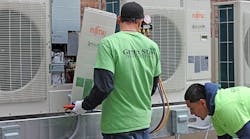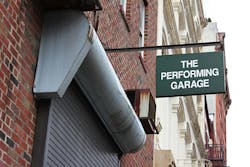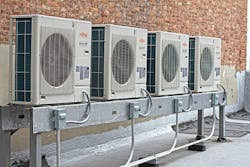NEW YORK — The Manhattan neighborhood of SoHo, so named for its location South of Houston Street, claims the highest concentration of iron-front buildings in the country. The metal’s addition to countless buildings, in the mid-1800s, revitalized the neighborhood, bringing new commercial tenants with it.
The same can be said of the art movement that swept into SoHo more than a century later. The otherwise stagnant industrial area gained new purpose and vigor as painters and performers began occupying the spacious lofts throughout SoHo.
The old manufacturing spaces converted beautifully into large studios full of natural light. But that’s where the amenities ended. Restrooms were few and HVAC was generally non-existent. Over the next few decades, creature comforts were often added, creating more livable spaces for the visionaries who occupied them.
Spectacularly monstrous system
At 33 Wooster Street, you’ll find the Performing Garage, an off-Broadway theater that’s been operating in SoHo since 1975. While the brick structure has changed little, it received its first central HVAC system in the early ‘90s. With the addition of two massive gas furnaces, the factory-turned theater could be used in the depths of winter without the fear of frostbite.
Half a block away, on top of a building shared by the same co-op, two condensers made a valiant effort to provide cooling while achieving only marginal comfort. In addition, four through-the-wall units also served the upstairs studio. The biggest issue was noise, both inside and out.
The reason the condensers weren’t installed directly on top of the theater was that tenants in adjacent apartments wouldn’t tolerate the noise. Inside the theater, system noise from the colossal ductwork was worse yet.
“During rehearsals and recording, we had to shut the HVAC system off,” explained Kathryn Valk, a founding member of The Performing Garage. “We’d periodically take a break and turn them on just so the temperature was tolerable.” To add insult to injury, the cooling system began leaking refrigerant, and energy consumption was unforgivable, year ‘round.
Enter help, stage left
Last summer, Valk and other managers at The Performing Garage were introduced to Green Star Energy Solutions by manufacturer’s representatives at Wales Darby. While HVAC is a core service provided by Green Star, the company is a full-spectrum building performance contractor.
Their focus is “holistic efficiency,” as they call it, where cutting-edge heating and cooling equipment is paired with building envelope improvements. Windows, doors, weatherization and insulation are an integral part of their solution.
“NYSERDA [New York State Energy Research and Development Authority] looks for 10 to 15 percent energy savings,” said Tom Esposito, director of business development at Green Star. “But we strive for 40 to 70 percent, and regularly achieve it.”
Members of The Performing Garage toured condos at nearby 400 Central Park West, where Green Star had recently installed a large VRF system. Brendan Casey, New York sales engineer at Fujitsu, was involved during the design, and joined the tour to help answer any questions.
Not long after, papers were signed to begin a two-phase effort to bring the theater into the 21st century. Phase one would include installation of a new HVAC system, and phase two would drastically improve the building envelope.
Act 1, scene 1
Green Star didn’t foresee any issues with installing new equipment in the building. What did pose a challenge, however, was getting a high-efficiency system to fit into a non-profit budget.
“The Performing Garage had a design before we met with them,” said Joe Novella, owner of Green Star. “There was no way the original design would fit in the budget. So we cut the price tag in half, and reduced the total capacity by 24 tons just by zoning more intelligently with a Fujitsu HFI system.”
“We use Fujitsu equipment regularly to provide solutions and energy savings for old buildings in New York,” said Esposito. “From the Halcyon mini-splits up through their Airstage VRF systems, the equipment is very reliable.”
Green Star initially considered using a VRF system, but the smaller Halcyon HFI systems were capable of handling the load and still offered plenty of flexibility through the use of branch boxes.
Installing the smaller condensers shaved upfront costs further, because a crane wasn’t needed. Instead of blocking off Wooster Street for a day to crane larger condensers onto the roof, four, 48,000 Btuh units were lifted through a skylight. Custom steel framework was erected to mount the units several feet above the flat roof, and all refrigerant lines enter the building through a single penetration.
Inside, 16 evaporators are used across four zones. The main theater is conditioned with wall-hung units down low, and two slim ducts on the ceiling toward the back of the room. Upstairs offices and common areas are also heated and cooled with wall units of various sizes. A small archive room is served by a 9,000 Btuh evaporator, mostly for humidity control.
Act 2, a better building
“The HVAC system can run during rehearsals now,” said Valk. “We’re far more comfortable, and the work was complete before our large annual banquet, as promised.” The star-studded event, which included Frances McDormand and Steve Buscemi, among others, raised funds for the building improvements.
Phase two is slated to begin later this year. Building improvements will bring the envelope up to par with the systems that serve it.
“Right now, the roof insulation is about R-8,” said Esposito. “We’ll create an air barrier, blow in a thick layer of L77 insulation and bring it up to R-45 or 50. The skylight will be sealed off with an energy barrier, and the old through-wall units will be removed and bricked off.”
These improvements are similar to those made by Green Star on more than 4,000 homes and hundreds of commercial buildings. But it’s the first time they’ve worked on a theater. So far, everyone using the space has seen, heard and felt a vast improvement. Before the curtains close on the project entirely, the bookkeepers are sure to agree.





